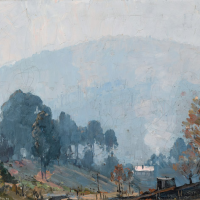13. ARTHUR STREETON

Although the various well known localities on the fringes of Melbourne, such as Templestowe and the Yarra Valley, had been subjects for Streeton since his earliest days as a painter, his extended series of paintings of the hilly, timbered scenery of the Dandenongs, particularly Olinda, began in earnest with Streetons return to Australia after twenty three years as an expatriate based in London. He bought five acres there in 1921, a year after his return, and the house he built there, Longacres, was completed in 1926.
Longacres and the surrounding area became the subject that continued to engage Streeton for the next twenty years, the remainder of his life. Initially a weekend retreat and place of contemplation, later in his life, after the death of his wife in1939, he moved there permanently.
The years in England had been eventful. Streeton used his time there to draw on the great traditions of English landscape painting and familiarise himself with all that was new as well. With paintings such as The Centre of the Empire 1902, Streeton asserted his technical credentials before an international audience, writing home best Ive done yet in England, terrific job1 The painting also proclaimed a commitment to the very idea of Britain and its empire at a time when Australia was burnishing its international connections.
By the time of Streetons return to Australia, however, England was still counting the cost of victory in the Great War and the world was a different place. In his London years, Streeton had enjoyed success, and made his own significant contribution to the War effort, but in 1920, married and with a young family, he could give consideration to the wholesome merits of Australia, and in particular could seek out a place such as Olinda for a restoration of faith.
The numerous paintings he produced there seem subtly different. At times Streetons Olinda landscapes have the character of political statements, but in general he employs a gentle touch, without the sometimes heavy-handed rhetoric of his English work. In Olinda, Streeton could respond to some of the lyrical qualities to be found in the Australian landscape. The paintings done there are uniquely personal; they are honest, direct, and on occasion alive with sentiment.
Streeton also became a confirmed environmentalist. In some of the Olinda paintings such as Last of the Messmates 1928, The Vanishing Forest 1934, and in particular with the extraordinary Sylvan Dam and Donna Buang AD 2000 painted in 1940, he documents with increasing vehemence the damage being done to the natural world and condemns the political and commercial interests that were responsible for it.
Footnotes
1. Streeton in correspondence with Tom Roberts, 14 February 1902, and Frederick Delmer, 17 April 1902, quoted in Smith, G., Arthur Streeton 1867-1943, National Gallery of Victoria, Melbourne, 1995, p.140
Timothy Abdallah BA